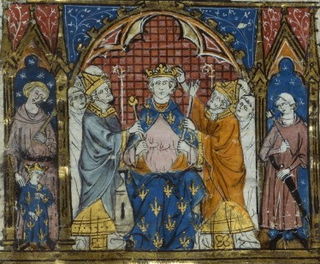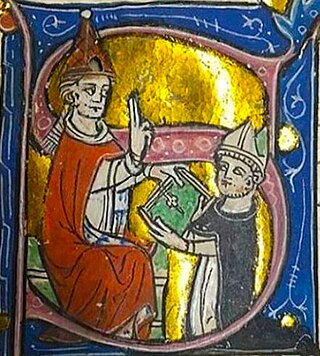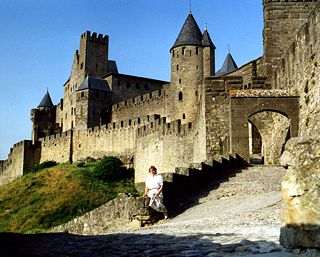Catharism was a Christian quasi-dualist or pseudo-Gnostic movement which thrived in Southern Europe, particularly in northern Italy and southern France, between the 12th and 14th centuries. Denounced as a heretical sect by the Catholic Church, its followers were attacked first by the Albigensian Crusade and later by the Medieval Inquisition, which eradicated the sect by 1350. Many thousands were slaughtered, hanged, or burnt at the stake, sometimes without regard for age or sex.

The Inquisition was a Catholic judicial procedure where the ecclesiastical judges could initiate, investigate and try cases in their jurisdiction. Popularly it became the name for various medieval and reformation-era State-organized tribunals whose aim was to combat heresy, apostasy, blasphemy, witchcraft, and other dangers, using this procedure. Studies of the records have found that the overwhelming majority of sentences consisted of penances, but convictions of unrepentant heresy were handed over to the secular courts for the application of local law, which generally resulted in execution or life imprisonment. If the accused was known to be lying from other credible evidence, a single short application of non-maiming, unbloody torture was allowed, to corroborate that evidence.

The Medieval Inquisition was a series of Inquisitions from around 1184, including the Episcopal Inquisition (1184–1230s) and later the Papal Inquisition (1230s). The Medieval Inquisition was established in response to movements considered apostate or heretical to Roman Catholicism, in particular Catharism and Waldensians in Southern France and Northern Italy. These were the first movements of many inquisitions that would follow.

Pope Benedict XI, born Nicola Boccasini, was head of the Catholic Church and ruler of the Papal States from 22 October 1303 to his death, in 7 July 1304.

Pope John XXII, born Jacques Duèze, was head of the Catholic Church from 7 August 1316 to his death, in December 1334. He was the second and longest-reigning Avignon Pope, elected by the Conclave of Cardinals, which was assembled in Lyon. Like his predecessor, Clement V, Pope John centralized power and income in the Papacy and lived a princely life in Avignon.

Year 1317 (MCCCXVII) was a common year starting on Saturday of the Julian calendar.

The Franciscans are a group of related mendicant religious orders of the Catholic Church. Founded in 1209 by the Italian saint Francis of Assisi, these orders include three independent orders for men, orders for nuns such as the Order of Saint Clare, and the Third Order of Saint Francis open to male and female members. They adhere to the teachings and spiritual disciplines of the founder and of his main associates and followers, such as Clare of Assisi, Anthony of Padua, and Elizabeth of Hungary. Several smaller Protestant Franciscan orders or other groups have been established since late 1800s as well, particularly in the Anglican and Lutheran traditions.
The Fraticelli or Spiritual Franciscans opposed changes to the rule of Saint Francis of Assisi, especially with regard to poverty, and regarded the wealth of the Church as scandalous, and that of individual churchmen as invalidating their status. The Fraticelli were declared heretical in 1296 by Boniface VIII.

Ubertino of Casale was an Italian Franciscan and one of the leaders of the Spirituals, the stricter branch of the Franciscan order.

Bernard Gui, also known as Bernardo Gui or Bernardus Guidonis, was a Limousin Dominican friar, Bishop of Lodève, and a papal inquisitor during the later stages of the Medieval Inquisition.

Nicholas Eymerich was a Roman Catholic theologian in Medieval Catalonia and Inquisitor General of the Inquisition in the Crown of Aragon in the later half of the 14th century. He is best known for authoring the Directorium Inquisitorum, that mostly summarized previous texts and mores.

The Diocese of Carcassonne and Narbonne is a Latin Church ecclesiastical jurisdiction or diocese of the Catholic Church in France. The diocese comprises the entire department of Aude. It is suffragan to the Archdiocese of Montpellier.

Bernard de Castanet was a French lawyer, judge, diplomat, bishop and cardinal of the Roman Catholic Church. Castanet was not a Dominican, though he had an excellent relationship with the order of the Preachers and occasionally exercised the office of inquisition as a bishop of Albi and a representative of the inquisitor of Carcassonne.
Peire Autier, Peire Authié or Pierre Authié was a Cathar Good Man (leader) in the Languedoc region of southern France. Originally a notary from Ax-les-Thermes, he travelled to Lombardy and Piedmont with his brother, Jacques, in the 1290s and converted to Catharism. During the winter of 1299–1300, he returned to Languedoc to revive the Cathar Church. He was arrested by the inquisitor Geoffroy d'Ablis in August 1309 and burned at the stake for heresy on April 10, 1310.
Jean de Picquigny was a French noble from Amiens who was viceroy of Languedoc. Known for arresting Bishop Bernard Saisset in 1301 as well as freeing Inquisition prisoners in Carcassonne, along with Bernard Délicieux, in 1303. For these controversial actions, he was excommunicated in 1303.

Jean de Beaune was a Dominican inquisitor in Carcassonne during the early 14th century who played a role in precipitating the Apostolic poverty controversy of the period.
Na Prous Boneta (1296-1328), was a French beguine. She was put on trial before the Inquisition in Carcassonne on 6 August 1325, and is known for the confession she gave.
Bernard de Caux, or in Latin Bernardo or Bernardus de Caucio, was a Dominican friar and medieval inquisitor. His activities mainly took place in the region of the County of Toulouse between 1243 and 1249. He originated the investigation processes and his witness interrogations are recorded in a 13th-century transcribed manuscript preserved in the library of Toulouse.
Jean-Louis Biget was a French historian who specialized in the Middle Ages.
France was one of the first countries where the papal inquisition was established in the 13th century. This ecclesiastical judicial institution was created to combat heresies. The southern region of France, Languedoc, was the primary center of inquisition activity in Europe until the mid-14th century. Most of the preserved sources concerning the inquisition originate from this region. However, the history of the French Inquisition spans until the end of the 17th century and also encompasses other areas of the country.












